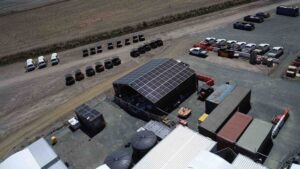Australian researchers have passed a major international milestone for the durability of next generation perovskite solar cells, a key step towards the commercialisation of ultra low cost solar panels.
In results published in the journal Science, scientists from the University of Sydney and the University of New South Wales have passed strict durability tests for long-term durability under real-world conditions, overcoming some of the degradation challenges that have plagued the promising perovskite cells.
Next generation perovskite solar cells have shown promise as a pathway to lower cost solar panels, as they can be produced from more readily available materials, and avoid reliance on the expensive, hyper-pure, silicon wafers used on conventional solar panels.
“Perovskites are a really promising prospect for solar energy systems,” the University of Sydney’s professor Anita Ho-Baillie said. “They are a very inexpensive, 500 times thinner than silicon and are therefore flexible and ultra-lightweight. They also have tremendous energy enabling properties and high solar conversion rates.”
However, the main challenge for perovskite solar cells has been durability, with the perovskite materials prone to breaking down when exposed to harsh environmental conditions. It has been this tendency to degrade without substantial protection that has limited the commercialisation potential of perovskite solar cells.
“Perovskite cells will need to stack up against the current commercial standards. That’s what is so exciting about our research. We have shown that we can drastically improve their thermal stability,” Professor Ho-Baillie said.

In a breakthrough led by researchers at the University of Sydney and the University of New South Wales, a new method of protecting the cells from the elements has been developed, that passed strict international testing standards for performance under heat and humidity without impacting on the performance of the cells.
The researchers studied the ways in which the perovskite materials degraded over time, and while observing the behaviour of perovskite materials when exposed to harsh sunlight or humidity, the researchers found that the materials began to release gas from within their structures, becoming unstable and losing performance.
“Understanding this process, called ‘outgassing’, is a central part of our work to develop this technology and to improve its durability,” professor Ho-Baillie said.
“I have always been interested in exploring how perovskite solar cells could be incorporated into thermal insulated windows, such as vacuum glazing. So, we need to know the outgassing properties of these materials.”
The researchers used a process to identify which particular materials were prone to breaking down, using a process called gas chromatography–mass spectrometry, which identified the signatures of the volatile compounds being released from the perovskite materials.
Once these materials were identified, the research team was then able to produce a specially designed polymer-glass that was used to seal the material, and prevent the perovskite material from breaking down.
Professor Ho-Baillie said that by adding this low-cost polymer-glass layer, that the durability of the perovskite solar cells improved dramatically, allowing the innovative solar cells to pass strict international testing, demonstrating that the cells could work in real-world conditions.
“Another exciting outcome of our research is that we are able to stabilise perovskite cells under the harsh International Electrotechnical Commission standard environmental testing conditions. Not only did the cells pass the thermal cycling tests, they exceeded the demanding requirements of damp-heat and humidity-freeze tests as well,” professor Ho-Baillie added.
It potentially opens up a pathway towards commercialisation for perovskite solar cells.
Perovskite solar cells also draw upon different parts of the light spectrum to those of conventional silicon cells, providing an opportunity for perovskite and silicon solar cells to be “stacked” upon each other to convert more sunlight into electricity.
A team of researchers at the Australian National University set a new world record conversion efficiency using these “stacked” solar cells, also called “tandem” solar cells, achieving a conversion efficiency of 27.7 per cent. The researchers believe that an efficiency of beyond 30 per cent is achievable.
Perovskite solar cells are also significantly more flexible than silicon solar cells, creating the potential that the next generation of solar technologies could be incorporated directly into materials, including building surfaces and the exteriors of electric vehicles.
Researchers at the University of New South Wales are already exploring how solar materials can be incorporated into the surfaces of structures like buildings or vehicles, and are looking to produce commercially viable ‘solar skins’.
RenewEconomy and its sister sites One Step Off The Grid and The Driven will continue to publish throughout the Covid-19 crisis, posting good news about technology and project development, and holding government, regulators and business to account. But as the conference market evaporates, and some advertisers pull in their budgets, readers can help by making a voluntary donation here to help ensure we can continue to offer the service free of charge and to as wide an audience as possible. Thankyou for your support.










